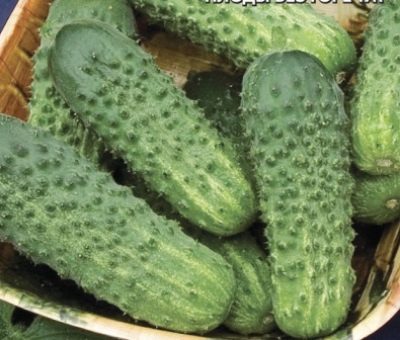
- Authors: Motov V.M., Biryukova N.K., Erdyakova V.A.
- Year of approval: 2003
- Growth type: vigorous, indeterminate
- Branching: strong
- Fruit weight, g: 100-110
- Fruit length, cm: 11-12
- Fruit color: green with white stripes
- Ripening terms: early
- Fruit shape: cylindrical
- Fruit taste: excellent, no bitterness
Gardeners appreciated the convenience of growing parthenocarpic early ripening cucumber hybrids. They do not require pollination, do not taste bitter, give a plentiful early harvest. Recently, the range of similar Russian and foreign breeding developments has become very rich. One of the examples of domestic selection is the Miranda cucumber.
Breeding history
Miranda F1 was received in the late 1990s from the Agrosemtoms Research and Production Company. This company was established in 1991 in the city of Kirov. The authors of Miranda were the director of the company, candidate of agricultural sciences Motov V.M. and leading experts Biryukova N.K. and Erdyakova V.A.
In 2003, the first-generation hybrid Miranda was included in the register of allowed for breeding in several regions of the Russian Federation, located to the west of the Ural Mountains. These are the northern and Northwestern regions, the Central Black Earth Region, the Central and Volgo-Vyatka regions, the North Caucasus and the Middle Volga.
Description of the variety
Miranda is an early maturing, high-yielding hybrid, unpretentious to weather surprises and disease-resistant for universal purposes. The plant is vigorous, indeterminate, with dense branching and parthenocarpic flowering. Suitable for cultivation in open ground, under a temporary shelter, in film greenhouses. The hybrid is short-fruited. Surface with moderate tubercles and pubescence.
Characteristics of the appearance of plants and zelents
Miranda bushes are tall (about 2 m) and spreading, with a developed root system and a large number of smooth leaves with an even edge. On the main stem, up to 14-15 nodes are formed, in which there are 1-3 ovaries. Female flowers predominate.
Zelentsy are notable for their small size: diameter about 4 cm, length up to 12 cm, weight from 100 to 110 g. The shape is cylindrical, the surface is slightly ribbed with tubercles and white thorns, the color is green with noticeable light longitudinal stripes. The skin is of medium density, the flesh is without voids, juicy, with a bright aroma.
Purpose and taste of fruits
Miranda cucumbers are used for slicing and salads, as well as for any preservation methods: for quick pickling and pickling for the winter. The taste is very good: the fruits are crunchy, never bitter, the skin is not tough, the seeds are practically not tasted, and during processing the cucumbers remain dense.
Maturation
Early ripening allows you to get the first harvest in 1.5 months after germination. The fruiting periods of Miranda on the territory of the Russian Federation are extended for the entire growing season and last from late June-early July to September.
Yield
Even with minimal maintenance, Miranda F1 yields a bountiful yield of 8-10 kg / m². The average number of fruits of high commercial quality according to the State Sort Commission is 6.3 kg / m².
Miranda cucumbers should be picked at the stage of milky ripeness, preventing them from overripe. It is recommended to harvest early in the morning or in the evening before watering. The fruits tolerate transportation well and can be stored for up to 5-6 days without losing their elasticity.In a cellar or refrigerator, the crop retains its marketable appearance and good taste characteristics for up to 3 weeks.
Landing scheme
For bushes of this type, comfortable growth and harvesting will be ensured by planting according to the scheme of 70 x 40 cm or 50 x 50 cm. When using trellises, 2-3 bushes are usually planted per 1 m².
Growing and caring
It is preferable to grow Miranda using the seedling method. Only in the southern regions of the North Caucasus is the sowing method suitable for open ground. In other climatic zones, seeds are sown in containers with prepared fertile soil mixture. The sprouts hatch quickly and amicably, after 6-7 days. Seedlings must be provided with good lighting so that they do not stretch out unnecessarily.
After 25-30 days, the bushes are planted in a prepared permanent place. Further care consists in the following activities:
- the device of a trellis on which strongly branching shoots are tied;
- regular hilling and weeding;
- gentle loosening of the root area;
- the introduction of alternating organic and complex mineral dressings;
- daily evening watering with warm water before frost.
Soil requirements
The main qualities of soil for seedlings or sowing: looseness and neutral acidity. You can fertilize the soil with humus or compost. The quality of the soil is improved by the addition of peat and sand.
An important indicator is the temperature of the soil: it must be warmed up to 14-15 ° C.

In order to collect strong, tasty and beautiful cucumbers on your site, you need to make top dressing. Lack of nutrients can negatively affect the appearance of the plant and significantly reduce the yield. Fertilize cucumbers with organic fertilizers in combination with mineral fertilizers. With the right balance of these components and adherence to the fertilizing schedule, the cucumber yield will be maximum.
Disease and pest resistance
Breeders managed to achieve Miranda's immunity to the main diseases of this culture: fusarium (root rot), brown olive spot, powdery mildew fungus and peronosporosis. Plants rarely suffer from pests, and the affected bush quickly recovers after sanitary pruning and spraying.

Despite their popularity, cucumbers are often attacked by diseases and pests. From them, cucumber plantings often die before the start of fruiting. In order to prevent this from happening, it is necessary to try to prevent ailments or get rid of them at the very beginning, having studied in detail their causes of occurrence, signs and methods of treatment.





























































































